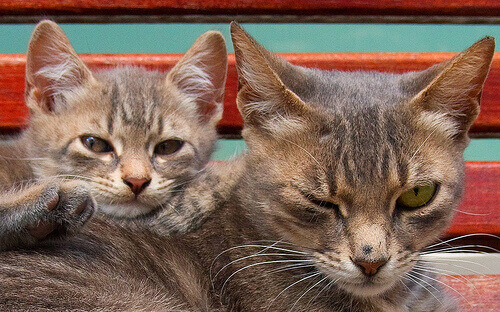How to Prepare for the Arrival of a Second Cat


Written and verified by the lawyer Francisco María García
Now that you’ve made the decision to bring a second cat home, it’s important to plan a healthy transition for the cat that’s already there. These creatures are usually independent, territorial, and, thus, rather protective of their environment. Thus, the arrival of a new member must be well-planned and done progressively.
Guardians must be sensitive as this is the key to establish peaceful coexistence between the two animals. The first cat shouldn’t feel that the new member is a threat or a replacement. On the contrary, they should see them as a new member of the family and possible companion.
A poor adjustment experience between two cats can lead to episodes of aggression. It can also trigger inappropriate behavior, such as urinating or defecating around the house, or even lead them to run away.
When is it time to bring a second cat home?
Make sure adopting a new animal is a good idea before you take the step. The instances when a new adoption is recommended have to do with a person’s routine.
- Will the cat spend too much time alone? A new companion for a cat is a good idea when their owners leave the house early and return late. Yes, we’ve all heard that cats are loners but they actually value spending time with their other creatures and playing with them.
- Is the cat you already have at home young and healthy? An adult cat may not like the arrival of a second cat at all. Mainly because their habits and routines are already well internalized. The same applies to a sick cat who’ll prefer quiet moments over new experiences.
- Has your existing cat lived with other cats and is used to their company? You must know how your cat got to you before adopting a second one. They wouldn’t be interested in the company of other cats if they were taken away from their litter before the age of three months because they’ve never interacted with them.

How to select a second cat
There are no indications that cats of the same breed adapt better than others. In principle, the breed shouldn’t be an imperative condition for selecting a second one.
The success of the acceptance of both animals will be directly related to the measures taken by the owners. Note that a faster adaptation is possible when the first cat is a male and the new one a female. The same goes for sterilized males or if both are female.
There’s also a good chance when the first cat is already an adult and the newcomer a kitten. The former would assume the role of a guardian and teach the little one the ropes.

Recommendations
- Firstly, delimit the space. The first thing you must do when bringing a new animal to your home is to keep them in a specific space. It must be a room that suits their needs and they should have no contact with the existing animal. This space will allow them to become familiar with the new guardians and their environment.
- Personalize the utensils. Each animal should have their own litter box, food dispenser, and water bowl — both in the adaptation stage and in the coexistence stage.
- Introduce the new smells. Impregnating a garment with the smell of the second cat and giving it to the first cat is an often recommended technique. It’s a good way for them to become familiar with the smell of their new companion and get used to their presence. You must do the same with the newcomer.
- Finally, allow eye contact. Once the animals have become familiar with each other’s smell, you may allow them to make eye contact. Allow them to interact the next day if it goes well.
The time required for each stage will depend on the cats. You must continuously monitor them to ensure a successful adaptation process. Start over if there are any signs of aggression, fear, or discomfort.
Thanks for reading.
Now that you’ve made the decision to bring a second cat home, it’s important to plan a healthy transition for the cat that’s already there. These creatures are usually independent, territorial, and, thus, rather protective of their environment. Thus, the arrival of a new member must be well-planned and done progressively.
Guardians must be sensitive as this is the key to establish peaceful coexistence between the two animals. The first cat shouldn’t feel that the new member is a threat or a replacement. On the contrary, they should see them as a new member of the family and possible companion.
A poor adjustment experience between two cats can lead to episodes of aggression. It can also trigger inappropriate behavior, such as urinating or defecating around the house, or even lead them to run away.
When is it time to bring a second cat home?
Make sure adopting a new animal is a good idea before you take the step. The instances when a new adoption is recommended have to do with a person’s routine.
- Will the cat spend too much time alone? A new companion for a cat is a good idea when their owners leave the house early and return late. Yes, we’ve all heard that cats are loners but they actually value spending time with their other creatures and playing with them.
- Is the cat you already have at home young and healthy? An adult cat may not like the arrival of a second cat at all. Mainly because their habits and routines are already well internalized. The same applies to a sick cat who’ll prefer quiet moments over new experiences.
- Has your existing cat lived with other cats and is used to their company? You must know how your cat got to you before adopting a second one. They wouldn’t be interested in the company of other cats if they were taken away from their litter before the age of three months because they’ve never interacted with them.

How to select a second cat
There are no indications that cats of the same breed adapt better than others. In principle, the breed shouldn’t be an imperative condition for selecting a second one.
The success of the acceptance of both animals will be directly related to the measures taken by the owners. Note that a faster adaptation is possible when the first cat is a male and the new one a female. The same goes for sterilized males or if both are female.
There’s also a good chance when the first cat is already an adult and the newcomer a kitten. The former would assume the role of a guardian and teach the little one the ropes.

Recommendations
- Firstly, delimit the space. The first thing you must do when bringing a new animal to your home is to keep them in a specific space. It must be a room that suits their needs and they should have no contact with the existing animal. This space will allow them to become familiar with the new guardians and their environment.
- Personalize the utensils. Each animal should have their own litter box, food dispenser, and water bowl — both in the adaptation stage and in the coexistence stage.
- Introduce the new smells. Impregnating a garment with the smell of the second cat and giving it to the first cat is an often recommended technique. It’s a good way for them to become familiar with the smell of their new companion and get used to their presence. You must do the same with the newcomer.
- Finally, allow eye contact. Once the animals have become familiar with each other’s smell, you may allow them to make eye contact. Allow them to interact the next day if it goes well.
The time required for each stage will depend on the cats. You must continuously monitor them to ensure a successful adaptation process. Start over if there are any signs of aggression, fear, or discomfort.
Thanks for reading.
This text is provided for informational purposes only and does not replace consultation with a professional. If in doubt, consult your specialist.








